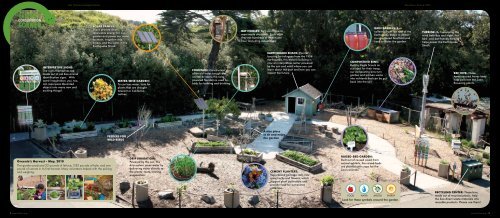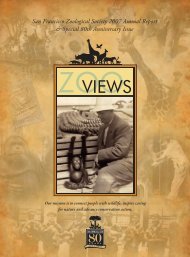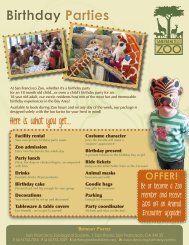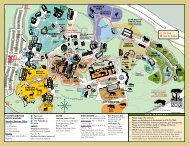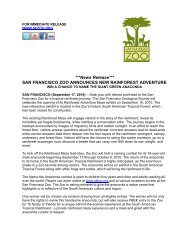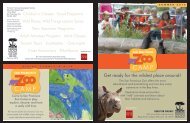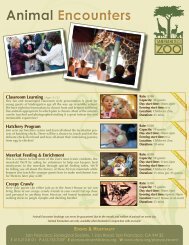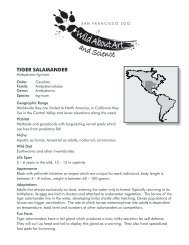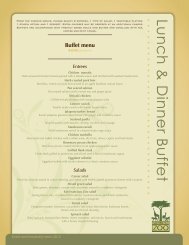Greenie's Conservation Corner Guide - San Francisco Zoo
Greenie's Conservation Corner Guide - San Francisco Zoo
Greenie's Conservation Corner Guide - San Francisco Zoo
Create successful ePaper yourself
Turn your PDF publications into a flip-book with our unique Google optimized e-Paper software.
<strong>San</strong> <strong>Francisco</strong> <strong>Zoo</strong>logical Society <strong>Zoo</strong> Views / Summer 2010<br />
Solar Panels:<br />
These provide clean,<br />
renewable energy for our<br />
garden and power our water<br />
fountain, irrigation drip<br />
timers, and the lights in the<br />
Earthquake Shack.<br />
Bat Houses: Bats can thrive in<br />
man-made structures. Each night<br />
they eat hundreds of insects per<br />
hour (including mosquitoes).<br />
Rain Barrels: Rain<br />
collected from the roof of the<br />
Earthquake Shack is stored<br />
in repurposed food bins and<br />
used to water the garden.<br />
Turbine: By harnessing the<br />
wind both day and night, this<br />
bird- and bat-friendly turbine<br />
helps power the Earthquake<br />
Shack.<br />
Interpretive Signs:<br />
The signs themselves are<br />
made out of old <strong>Zoo</strong> animal<br />
identification signs. With<br />
some imagination, you, too,<br />
can repurpose discarded<br />
objects into many new and<br />
exciting things!<br />
Water-Wise Garden:<br />
To use less water, look for<br />
plants that are drought<br />
tolerant or California<br />
natives.<br />
Fountain: Constructed<br />
of an old water trough and<br />
animal drinkers, the solar<br />
powered fountain is used by<br />
birds for bathing and drinking.<br />
Earthquake Shack: Former<br />
housing for refugees from the 1906<br />
earthquake, this historic building is<br />
now an interpretive center powered<br />
by the sun and wind where you can<br />
learn about the past and how you can<br />
impact the future.<br />
Composting Bins:<br />
Built by Eagle Scouts as<br />
a project for their troop,<br />
our composting bins turn<br />
garden and kitchen waste<br />
into nutrients that can be put<br />
back into the soil.<br />
Bee Hive: These<br />
Americanized honey bees<br />
help pollinate the <strong>Zoo</strong>’s<br />
flowering plants.<br />
Feeders for<br />
wild birds<br />
A nice place<br />
to sit and enjoy<br />
the garden<br />
Greenie’s Harvest - May, 2010<br />
The garden produced 22 pounds of lettuce, 2.82 pounds of kale, and one<br />
pound of carrots in its first harvest. Many volunteers helped with the picking<br />
and weighing.<br />
Drip Irrigation:<br />
Powered by the sun, this<br />
drip system saves water by<br />
delivering water directly to<br />
the plants’ roots, limiting<br />
evaporation.<br />
Cement Planters:<br />
Repurposed garbage cans now<br />
grow herbs and flowers, which<br />
support plant pollinators and<br />
provide food for our animal<br />
collection.<br />
Raised-Bed Garden:<br />
Built out of reused wood from<br />
animal exhibits, the raised-beds<br />
are planted with crops for the<br />
<strong>Zoo</strong>’s animals.<br />
FOOD WATER SHELTER ENERGY<br />
Look for these symbols around the garden.<br />
Recycling Center: These bins,<br />
made out of recycled plastic, help<br />
the <strong>Zoo</strong> direct waste materials into<br />
reusable products. Please use them!<br />
8 www.sfzoo.org<br />
www.sfzoo.org 10
<strong>San</strong> <strong>Francisco</strong> <strong>Zoo</strong>logical Society <strong>Zoo</strong> Views / Summer 2010<br />
<strong>Zoo</strong> Views / Summer 2010<br />
DON’T JUST VISIT THE<br />
ZOO – EXPLORE IT!<br />
Greenie’s <strong>Conservation</strong><br />
<strong>Corner</strong> Naturalist <strong>Guide</strong><br />
The <strong>Zoo</strong> sees many seasonal changes to its plants, wild<br />
birds, mammals and insects, making each visit different<br />
if you know what to look for. Especially in Greenie’s<br />
<strong>Conservation</strong> <strong>Corner</strong>, you can spend a lot of time on a<br />
seasonal scavenger hunt! See if you can find all of these<br />
this summer.<br />
PLANTS OF CONSERVATION CORNER<br />
SUNFLOWER (Helianthus annuums)<br />
These tall plants with their bright yellow<br />
pollen-laden centers attract many bees and<br />
other beneficial insects and birds.<br />
CALIFORNIA MILKWEED (Asclepias fascicularis)<br />
This water-wise native plant has very<br />
narrow leaves. It is a host plant for the<br />
monarch butterfly and the only plant<br />
that monarch larvae eat.<br />
HUMMINGBIRD SAGE (Salvia spathacea)<br />
This plant has flowering spikes with magenta<br />
flowers, which are worked heavily by<br />
hummingbirds for nectar.<br />
CALIFORNIA LILAC (Ceanothus ‘Concha’)<br />
This California native plant with its brilliant<br />
blue/purple spring flowers provides good<br />
cover and nesting sites for many California<br />
birds and is also a water-wise choice for a<br />
garden.<br />
LAVENDER (Lavendula sp.)<br />
With its small, purple flowering spikes, this<br />
aromatic member of the mint family attracts<br />
many types of bees for its sweet nectar.<br />
BUTTERFLIES AND BUGS OF<br />
CONSERVATION CORNER<br />
THE SWALLOWTAILS, “ANISE AND WESTERN<br />
TIGER” (Papilio zelicaon & Papilio rutulus)<br />
These large, yellowish<br />
butterflies have “tails” that<br />
help distinguish them from<br />
others. Look for them over the<br />
flowers and lawn.<br />
PAINTED LADY (Vanessa cardui)<br />
Look for the identifying row of eye spots<br />
on the underside of the wing of this large<br />
butterfly. Like the swallowtails, they are<br />
attracted to the nectar in the summer<br />
flowers.<br />
LADYBIRD BEETLE (Coccinellidae family)<br />
More affectionately called the ”ladybug;”<br />
these small, shiny insects are usually red with<br />
black spots and are the gardener’s friend as<br />
they eat plant-destroying insects like aphids.<br />
HONEY BEE (Apis mellifera)<br />
The European (now known as the western)<br />
honey bee was introduced by the early<br />
European settlers to America. They are<br />
famous for their honey and importance to<br />
the food you eat. They can live in manmade<br />
structures as well as trees. There are wild colonies all<br />
around the <strong>Zoo</strong>.<br />
SWEAT AND BUMBLE BEE<br />
(Halictidae & Bombus families)<br />
Of the 4,000 species of bee native to the<br />
United States, about 1,600 are found in<br />
California. Sweat (small and sometimes<br />
metallic-looking) and bumble (fuzzy, black<br />
and yellow) bees are two good examples of<br />
our local natives. Look for them near the Native Bee House<br />
or on the flowers.<br />
DARNER DRAGONFLY (Aeshnidae family)<br />
You can tell dragonflies apart from damsel<br />
flies in the resting phase – dragonflies don’t<br />
fold their wings. Darners eat other insects<br />
and can be seen darting over the grass and<br />
resting on the lip of the water fountain.<br />
BIRDS OF CONSERVATION CORNER<br />
AMERICAN GOLDFINCH (Spinus tristis)<br />
This vivid yellow migratory bird is adapted<br />
for the consumption of seed heads; its agile<br />
feet grip the stems while its conical beak<br />
removes the seeds. Look for them hanging<br />
on the seed socks.<br />
PURPLE AND HOUSE FINCH<br />
(Carpodacus purpureus & Carpodacus mexicanus)<br />
The males of these summer<br />
birds have bright red purplish<br />
heads but the house finch<br />
has brown streaks on the<br />
breast. Both love seeds and<br />
eat some insects.<br />
ANNA’S HUMMINGBIRD (Calypte anna)<br />
The adult male has an iridescent crimson<br />
red crown and throat; and a dark, slightly<br />
forked tail. Anna’s is the only North American<br />
hummingbird species with a red crown.<br />
Females and juveniles have a green crown.<br />
Find them perching on the lip of the fountain or zipping<br />
about the garden.<br />
BROWN CREEPER AND PYGMY NUTHATCH<br />
(Certhia americana & Sitta pygmaea)<br />
Look for these two small brown birds<br />
in the tree near the bat houses. Brown<br />
creepers have a hooked bill and tend<br />
to hop up the trunks looking for insects.<br />
The pygmy nuthatch tends to start at<br />
the top and hops down the tree looking<br />
for insects.<br />
Five Things Kids Can Do to Help Pollinators<br />
1. Be kind to your pollinator friends. Bugs and birds are small<br />
and fragile. Be gentle and quiet when they are near!<br />
2. Look, but don’t touch! Pollinators won’t hurt you if you<br />
leave them alone.<br />
3. Don’t use poison sprays. Poison sprays might kill “bad”<br />
bugs in your garden, but they hurt pollinators, too, and non-<br />
ORGANIC fruits and vegetables can hurt you, too.<br />
4. Keep pollinators’ homes safe. Plant a garden for them.<br />
And when you find a bug in your house, gently take it outside<br />
rather than squishing it.<br />
5. Bug someone! Teach your family and friends about these<br />
important and fun animals.<br />
Greenie’s <strong>Conservation</strong> <strong>Corner</strong><br />
Opening Day<br />
For the grand opening of Greenie’s <strong>Conservation</strong><br />
<strong>Corner</strong>, 42 first grade elementary school students from<br />
Harvey Milk Civil Rights Academy and 60 third grade<br />
students from Fairmount Elementary School helped kick<br />
off the celebratory event, along with a beautiful Harris<br />
hawk from the <strong>Zoo</strong>’s Animal Resource Center. More than<br />
20 Salesforce.com volunteers helped commemorate the<br />
occasion by assisting students with a take-home seed<br />
and potting project. The materials and supplies for the<br />
project, as well as much of Greenie’s <strong>Conservation</strong><br />
<strong>Corner</strong>, were made possible by the Salesforce.com<br />
Foundation. Students also enjoyed hands-on projects<br />
from Scroungers Center for Resuable Art Parts and the<br />
Ecology Center of <strong>San</strong> <strong>Francisco</strong><br />
Naturalist <strong>Guide</strong><br />
Don't just visit it – explore it!<br />
Pull out<br />
guide for<br />
your next<br />
<strong>Zoo</strong> visit!<br />
11 www.sfzoo.org<br />
www.sfzoo.org 12<br />
www.sfzoo.org 7


